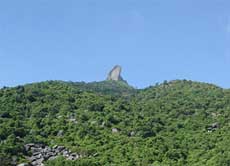Visitors to Da Bia Mountain in Dong Hoa District in the central province of Phu Yen are always surprised by what they see, depending on their perspective.
 There is a slope at the top of the mountain which bears a resemblance to a lion lying on its side, and from the Hao Son – Dap Han T-junction, one can make out a shape that looks like a tower. From Xep and Bai beaches, the mountain looks like the figure of a seated man, while from Hoa Tam School, it resembles a Buddha standing.
There is a slope at the top of the mountain which bears a resemblance to a lion lying on its side, and from the Hao Son – Dap Han T-junction, one can make out a shape that looks like a tower. From Xep and Bai beaches, the mountain looks like the figure of a seated man, while from Hoa Tam School, it resembles a Buddha standing.
Da Bia Mountain is also called Thach Bi Son (Thach Bi Mountain). Legend has it that in 1471, after defeating Cham army, King Le Thanh Tong made a stop here. He had writing carved on the rocks as a stele to mark the country’s boundary.
It has also been known as “Thien Nam De Nhat Tru†(the highest pillar of the southern region) because it stands at a height of 706 meters above sea level. When viewed from offshore, the huge 80-meter-high rock on the top of the mountain looks like an index finger pointing high into the sky, which is why French sailors back in 19th century referred to Da Bia Mountain as a “God’s Finger†(le Doigt de Dieu).
But no matter how you view it, Da Bia Mountain is a beautiful spot, with ranges of primeval forests and diverse flora and, it is thought, some plants with medicinal value.
The scramble up the top of the mountain is a 2.2-kilometer trek undertaking on 2,071 stone stairs. On reaching the top, one is rewarded with a panoramic view of Vung Ro, Ca Pass and Hao Son Lagoon.
The mountain is also home to many animal-shaped rocks like rabbits, chicken, tortoises, carp as well as many caves and waterfalls hidden in the immense forests.